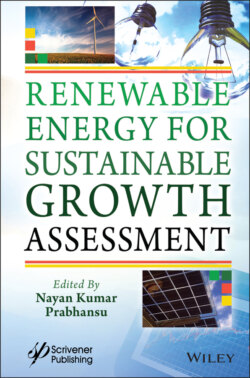Читать книгу Renewable Energy for Sustainable Growth Assessment - Группа авторов - Страница 60
2.4.3 Methodology 2.4.3.1 The TOPSIS Method
ОглавлениеThe TOPSIS is a well-known MCDM method. The concept on which this method is based is the distance of alternatives from best solution [84]. Accordingly, the most suitable alternative will be nearest from the best solution and far away from the worst solution [85, 86]. The best solution is one which maximizes the beneficial indicators and minimizes the non-beneficial indicators.
The steps of the TOPSIS method are described as follows:
a. A decision matrix wherein columns represent indicators (I1, I2, I3, …, In), (j = 1, 2, …, n) and rows represent alternatives (A1, A2, A3, . . . Am), (i = 1, 2, …, m) has to be established.(2.1)Table 2.3 Indicators value for each technology with range in brackets.RE technologyEfficiency (I1)Respond to peak demand (I2)Capacity factor (I3)LCOE (I4)Service life (I5)Land use (I6)GHG emissions (I7)Social acceptance (I8)Social risks (I9)Environmental risks (I10)Large hydropower80 [80-95]5 [4-5]45 [35-56]0.047 [0.044-0.049]50 [30-80]160 [2-750]18.5 [2-75]1 [1-2]5 [4-5]5 [4-5]Small hydropower80 [70-90]1 [1-2]45 [34-56]0.06 [0.02-0.10]35 [30-60]0.5 [.003-1]5 [0.3-13]3 [2-4]3 [2-4]3 [2-4]Solar PV15 [15-18]1 [1-2]18 [14-18]0.062 [0.045-.068]25 [20-35]20 [1-64]48 [9-300]5 [4-5]1 [1-2]2 [2-3]Onshore wind power35 [30-40]1 [1-2]25 [20-32]0.05 [0.033-0.083]25 [20-25]100 [72-137]11 [7-124]5 [4-5]2 [1-2]1 [1-2]Bioenergy50 [35-60]3 [3-4]64 [40-85]0.057 [0.04-0.09]20 [20-30]900 [72-2200]230 [14-1000]4 [3-5]3 [2-4]4 [3-5]An element Xij in Eq. (2.1) represents the value of the ith alternative Ai, for the jth indicator Ij.
b. The normalization of decision matrix as presented by rij is shown below(2.2)
c. The rij is now multiplied to respective weights (Wj) of indicators to obtain the matrix vij as calculated in Eq. (2.3).(2.3)Wj in Eq. (2.3) is the corresponding weight of the indicator
d. The best solution (V+) and worst solutions (V−) is then calculated as shown in below equations:(2.4)(2.5)J is the set of beneficiary indicators and j’ is of non-beneficiary indicators.
e. The distance of separation of each alternative from the best and the worst solution is calculated as:(2.6)(2.7)
f. The corresponding closeness of the alternative Aij from the best solution is calculated as:(2.8)
g. Finally, according the value of Ri in descending order the alternatives are ranked.
